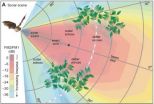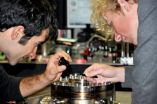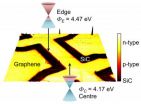(Press-News.org) PROVIDENCE, R.I. [Brown University] — Amid a neuroscience debate about how people and animals focus on distinct objects within cluttered scenes, some of the newest and best evidence comes from the way bats "see" with their ears, according to a new paper in the Journal of Experimental Biology. In fact, the perception process in question could improve sonar and radar technology.
Bats demonstrate remarkable skill in tracking targets such as bugs through the trees in the dark of night. Brown University neuroscience Professor James Simmons, the review paper's author, has long sought to explain how they do that.
It turns out that experiments in Simmons' lab point to the "temporal binding hypothesis" as an explanation. The hypothesis proposes that people and animals focus on objects versus the background when a set of neurons in the brain attuned to object features all respond in synchrony, as if shouting in unison "yes, look at that!" When the neurons don't respond together to an object, the hypothesis predicts, an object is relegated to the perceptual background.
Because bats have an especially acute need to track prey through crowded scenes, albeit with echolocation rather than vision, they have evolved to become an ideal testbed for the hypothesis.
"Sometimes the most critical questions about systems in biology that relate to humans are best approached by using an animal species whose lifestyle requires that the system in question be exaggerated in some functional sense so its qualities are more obvious," said Simmons, who plans to discuss the research at the 2014 Cold Spring Harbor Asia Conference the week of September 15 in Suzhou, China.
A Focus of Frequencies
Here's how he's determined over the years that temporal binding works in a bat. As the bat flies it emits two spectra of sound frequencies – one high and one low– into a wide cone of space ahead of it. Within the spectra are harmonic pairs of high and low frequencies, for example 33 kilohertz and 66 kilohertz. These harmonic pairs reflect off of objects and back to the bat's ears, triggering a response from neurons in its brain. Objects that reflect these harmonic pairs back in perfect synchrony are the ones that stand out clearly for the bat.
Of course it's more complicated than just that. Many things could reflect the same frequency pairs back at the same time. The real question is how a target object would stand out. The answer, Simmons writes, comes from the physics of the echolocation sound waves and how bat brains have evolved to process their signal. Those factors conspire to ensure that whatever the bat keeps front-and-center in its echolocation cone will stand out from surrounding interference.
The higher frequency sounds in the bat's spectrum weaken in transit through the air more than lower frequency sounds. The bat also sends out the lower frequencies to a wider span of angles than the high frequencies. So For any given harmonic pair, the farther away or more peripheral a reflecting object is, the weaker the higher frequency reflection in the harmonic pair will be. In the brain, Simmons writes, the bat converts this difference in signal strength into a delay in time (about 15 microseconds per decibel) so that harmonic pairs with wide differences in signal strength end up being perceived as way out of synchrony in time. The temporal binding hypothesis, predicts that the distant or peripheral objects with these out-of-synch signals will be perceived as the background while front-and-center objects that reflect back both harmonics with equal strength will rise above their desynchronized competitors.
With support from sources including the U.S. Navy, Simmons's research group has experimentally verified this. In key experiments (some dating back 40 years) they've sat big brown bats at the base of a Y-shaped platform with a pair of objects – one a target with a food reward and the other a distractor – on the tines of the Y. When the objects are at different distances, the bat can tell them apart and accurately crawl to the target. When the objects are equidistant, the bat becomes confused. Crucially, when the experimenters artificially weaken the high-pitched harmonic from the distracting object, even when it remains equidistant, the bat's acumen to find the target is restored.
In further experiments in 2010 and 2011, Simmons' team showed that if they shifted the distractor object's weakened high frequency signal by the right amount of time (remember: 15 microseconds per decibel) they could restore the distractor's ability to interfere with the target object by restoring the synchrony of the distractor's harmonics. In other words, they used the specific predictions of the hypothesis and their understanding of how it works in bats to jam the bat's echolocation ability.
If targeting and jamming sound like words associated with radar and sonar, that's no coincidence. Simmons works with the U.S. Navy on applications of bat echolocation to navigation technology. He recently began a new research grant from the Office of Naval Research that involves bat sonar work in collaboration with researcher Jason Gaudette at the Naval Undersea Warfare Center in Newport, R.I.
Simmons said he believes the evidence he's gathered about the neuroscience of bats not only supports the temporal binding hypothesis, but also can inspire new technology.
"This is a better way to design a radar or sonar system if you need it to perform well in real-time for a small vehicle in complicated tasks," he said.
INFORMATION:
In addition to the Office of Naval Research (grants: N00014-04-1-0415, N00014-09-1-0691), support for Simmons' research also comes from the National Science Foundation (IOS-0843522), the National Institutes of Health (R01-MH069633), the NASA/RI Space grant and the Brown Institute for Brain Science.
Bats bolster brain hypothesis, maybe technology, too
2014-08-15
ELSE PRESS RELEASES FROM THIS DATE:
A study of possible extended symmetries of field theoretic systems
2014-08-15
There has been much recent interest, especially among cosmologists, in theories known as galileons. Galileons are an interesting and novel, though still hypothetical, class of effective scalar fields which are extremely universal and have attracted much recent attention. They arise generically in describing the short distance behavior of the new degrees of freedom introduced during the process of modifying gravity, and in describing the dynamics of extra dimensional brane worlds. Modified gravity and brane worlds are just some of the ideas that have been studied as possible ...
Low vitamin D levels linked to increased risks after noncardiac surgery
2014-08-15
August 15, 2014 – Patients with low blood levels of vitamin D are at increased risk of death and serious complications after noncardiac surgery, suggests a study in Anesthesia & Analgesia.
"Vitamin D concentrations were associated with a composite of in-hospital death, serious infections, and serious cardiovascular events," according to the new research by Dr Alparslan Turan and colleagues of the Cleveland Clinic. They believe their results warrant further study to see if giving vitamin D supplementation before surgery can reduce the risk of these adverse outcomes.
Lower ...
Study: Brain imaging shows brain differences in risk-taking teens
2014-08-15
According to the CDC, unintentional injuries are the leading cause of death for adolescents. Compared to the two leading causes of death for all Americans, heart disease and cancer, a pattern of questionable decision-making in dire situations comes to light in teen mortality. New research from the Center for BrainHealth at The University of Texas at Dallas investigating brain differences associated with risk-taking teens found that connections between certain brain regions are amplified in teens more prone to risk.
"Our brains have an emotional-regulation network that ...
Laser makes microscopes way cooler
2014-08-15
Laser physicists have found a way to make atomic-force microscope probes 20 times more sensitive and capable of detecting forces as small as the weight of an individual virus.
The technique, developed by researchers at The Australian National University (ANU), hinges on using laser beams to cool a nanowire probe to minus 265 degrees Celsius.
"The level of sensitivity achieved after cooling is accurate enough for us to sense the weight of a large virus that is 100 billion times lighter than a mosquito," said Dr Ben Buchler from the ANU Research School of Physics and Engineering.
The ...
Adipose-derived stem cells and nerve regeneration
2014-08-15
Stem cell researchers at the Blond McIndoe Laboratory, University of Manchester, UK, led by Dr Adam Reid, present a review of the current literature on the suitability of adipose-derived stem cells in peripheral nerve repair.
Injuries to peripheral nerves are common and cause life-changing problems for patients alongside high social and health care costs for society. Current clinical treatment relies on sacrificing a nerve from elsewhere in the body to provide a nerve graft at the injury site, but much work has been done to develop a bioengineered nerve graft that would ...
Politicians need to address transport taboos, not just new technology, to meet carbon targets
2014-08-15
Transport accounts for 30% of CO2 emissions in the EU, with emissions rising 36% between 1990 and 2007. The research, carried out by Lund University and the University of Surrey a found a need to dissect the widely-held view that new technologies, such as biofuel and improved aircraft design, will result in carbon reduction targets being met.
In the paper, researchers highlight the fact that policy makers are turning to the perceived benefits of such technologies to drive decarbonisation policy, despite contrary evidence. They argue that in order to cut damaging carbon ...
On the edge of graphene
2014-08-15
Researchers at the National Physical Laboratory (NPL) have discovered that the conductivity at the edges of graphene devices is different to that of the central material.
Local scanning electrical techniques were used to examine the local nanoscale electronic properties of epitaxial graphene, in particular the differences between the edges and central parts of graphene Hall bar devices. The research was published in Scientific Reports, an open access publication from Nature Publishing Group.
The researchers found that the central part of the graphene channel demonstrated ...
TUM researchers develop defense against cyberattacks
2014-08-15
Port scanners are programs that search the Internet for systems that exhibit potential vulnerabilities. According to the report published today by journalists at Heise Online, Hacienda is one such port scanning program. The report says that this program is being put into service by the "Five Eyes," a federation of the secret services of the USA, Canada, the UK, Australia and New Zealand. "The goal is to identify as many servers as possible in other countries that can be remotely controlled," explains Dr. Christian Grothoff, Emmy Noether research group leader at the TUM ...
Experts close to perfect in determining truth in interrogations using active question methods
2014-08-15
Washington, DC (August 12, 2014) – Determining deception is a tool of the trade for law enforcement. The Good Cop/Bad Cop routine is etched in our minds as an effective method of finding out the truth. But prior research has shown that lie detecting is a 50/50 shot for experts and non-experts alike. So what exactly can we do to find out the truth? A recent study published in Human Communication Research by researchers at Korea University, Michigan State University, and Texas State University - San Marcos found that using active questioning of individuals yielded near-perfect ...
The beetle's white album
2014-08-15
The physical properties of the ultra-white scales on certain species of beetle could be used to make whiter paper, plastics and paints, while using far less material than is used in current manufacturing methods.
The Cyphochilus beetle, which is native to South-East Asia, is whiter than paper, thanks to ultra-thin scales which cover its body. A new investigation of the optical properties of these scales has shown that they are able to scatter light more efficiently than any other biological tissue known, which is how they are able to achieve such a bright whiteness. ...



